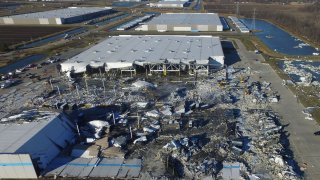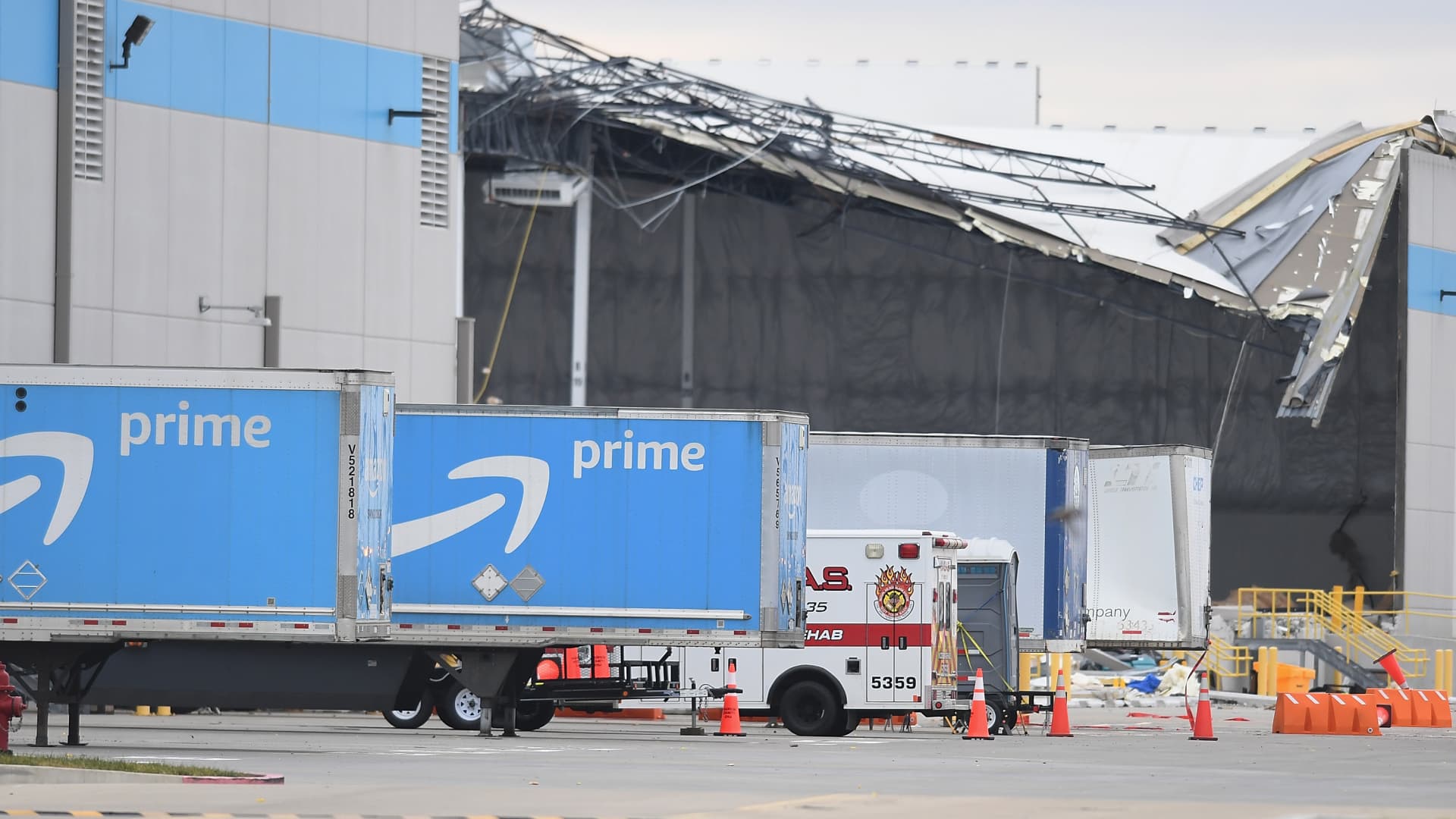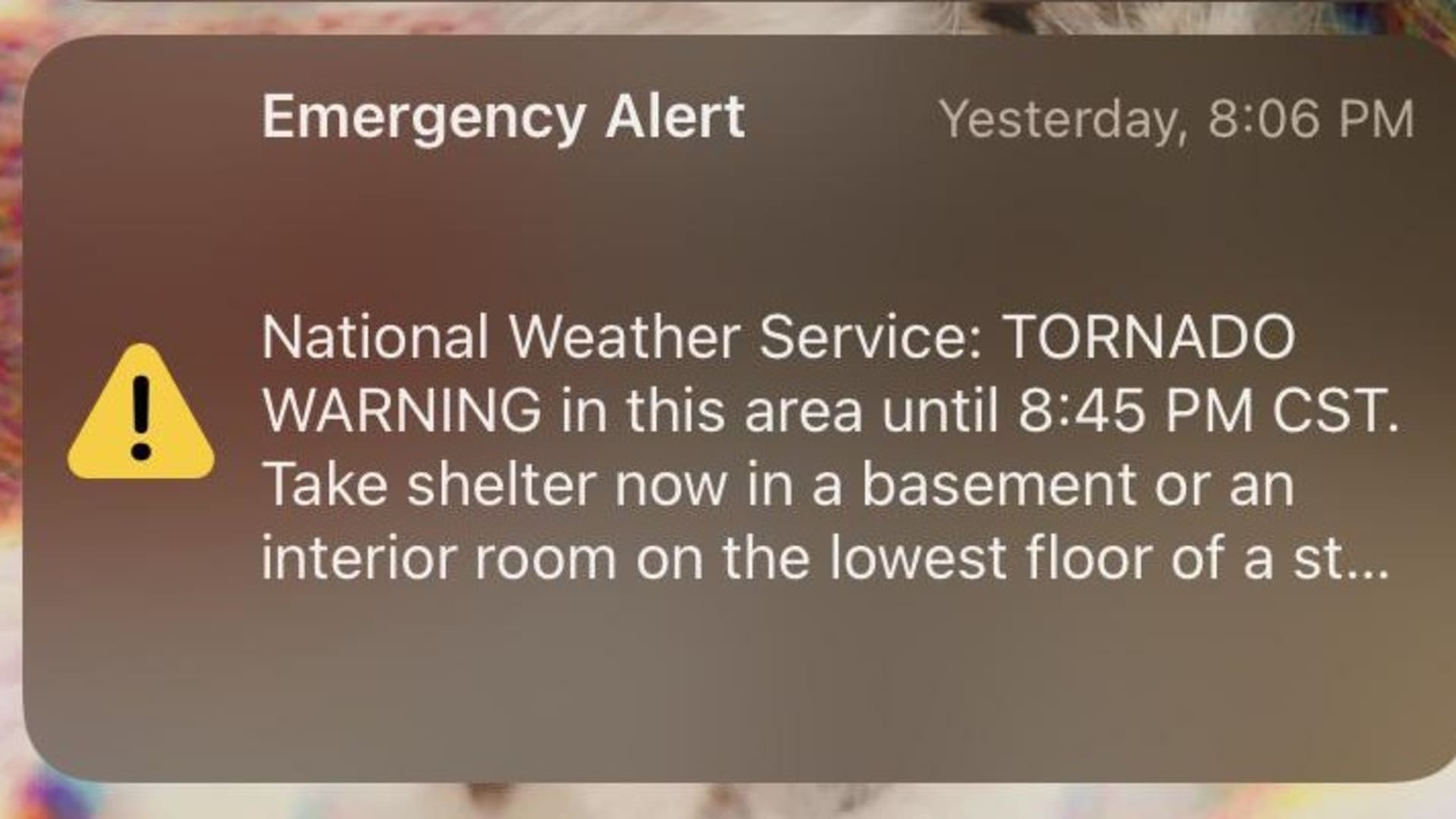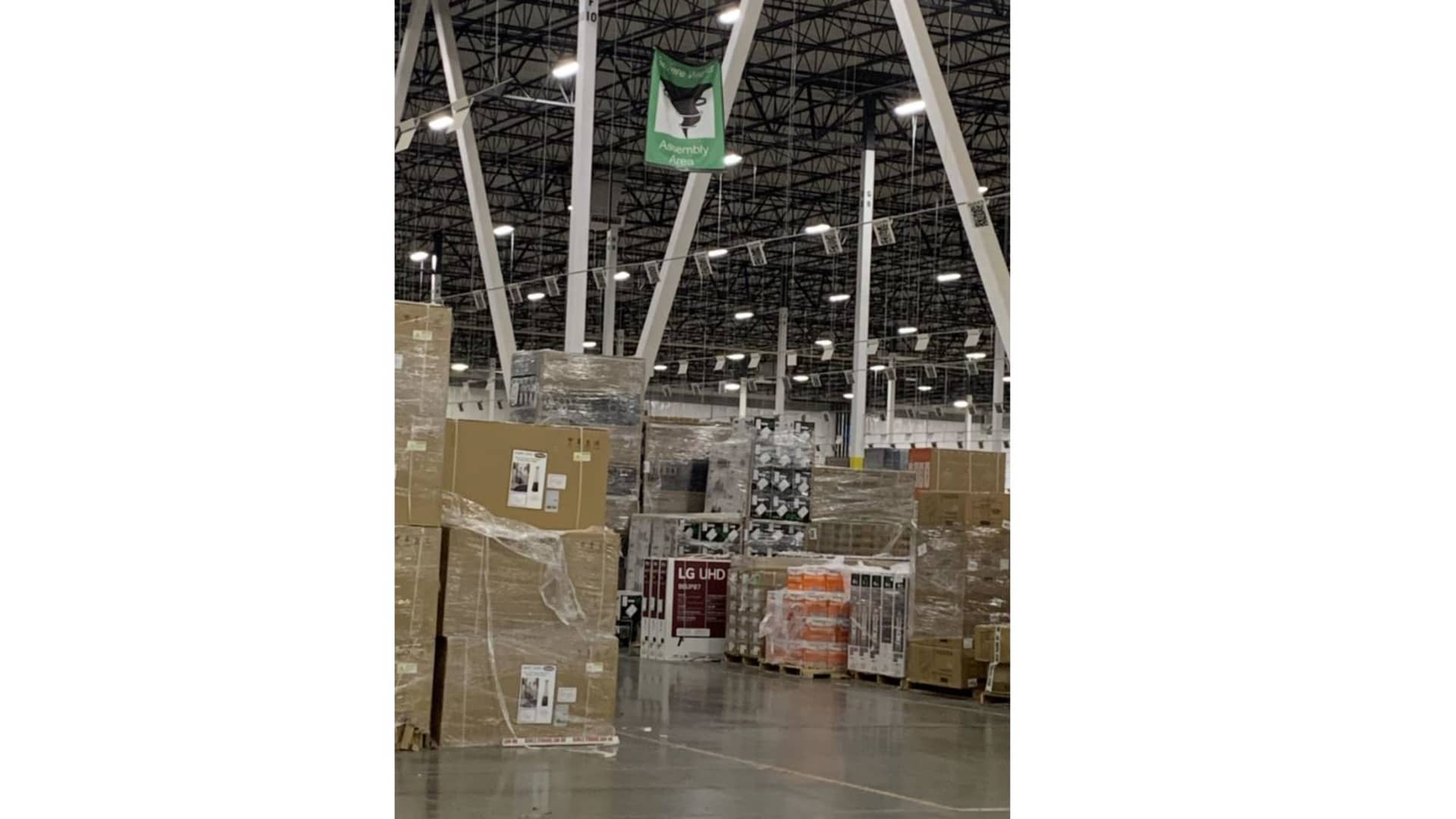
- The collapse of an Amazon warehouse in Edwardsville, Illinois, has spurred questions about the company's workplace safety policies and whether federal regulations on emergency preparedness should be strengthened.
- Six workers died in the collapse. Many of the victims were delivery drivers, who pulled into the facility just before the storm hit and frantically fled to a bathroom in the building's south side.
Gary Quigley was nearing the end of his Amazon delivery route on Friday when he noticed the winds were picking up.
WATCH ANYTIME FOR FREE
>Stream NBC10 Boston news for free, 24/7, wherever you are. |
Quigley had been listening to local radio stations in Edwardsville, Illinois, all afternoon to keep an eye on the weather forecast. Earlier in the day, the National Weather Service had called for severe storms and "strong tornadoes" in the area.
At about 7:30 p.m. local time, Quigley called his dispatcher, Kevin Dickey, who helped oversee the drivers at his contracted delivery company, Xseed. Both men agreed the weather was getting worse. Dickey told Quigley to head back to the Amazon warehouse in Edwardsville, known as DLI4.
Get updates on what's happening in Boston to your inbox. Sign up for our >News Headlines newsletter.
Quigley pulled in at DLI4 to clock out of his shift and stopped to chat with Dickey.
"He asked me if it was getting bad out there," Quigley recalled. "Then he told me to go ahead and get home safe and that he'd see me tomorrow."
It would be the last time Quigley spoke with Dickey.
Money Report
Dickey, 62, was one of six workers who died Dec. 10 after a tornado barreled through the Edwardsville warehouse.
The EF-3 tornado touched down at approximately 8:28 p.m. local time with wind speeds of 150 mph. The 1.1 million-square-foot facility's roof collapsed, while 40-foot-tall, 11-inch-thick concrete walls on the sides of the building fell inward.
The warehouse collapse has generated fresh scrutiny of Amazon's workplace safety measures. It has also raised questions about whether regulations and building codes need to be updated, especially as climate change fuels more frequent weather disasters.
Last week, the Occupational Safety and Health Administration said it opened a probe into the warehouse collapse. Local officials are also investigating the incident "to make sure all of the code was followed in the building and to find out exactly what occurred," Illinois Gov. J.B. Pritzker said in a news conference last week.
On Monday, 23 lawmakers wrote a letter to Amazon CEO Andy Jassy and founder Jeff Bezos seeking more information about what happened at the Edwardsville warehouse and whether what they called the company's "anti-worker policies that prioritize profits over worker safety" contributed to the incident.
Amazon spokesperson Kelly Nantel said the company is reviewing the letter.
The building was constructed consistent with code, Nantel said during the news conference last week.
"We want to go back and look at every aspect of this," Nantel continued. "There's always going to be tremendous learnings from any type of catastrophic event like this and we want to make sure our policies, our practices are consistent with any learnings that we have from this event and with all best practices."

'We all got together, and the building just fell'
As Quigley was driving out of DLI4's parking lot on his way home, he passed an Amazon delivery van and waved.
Inside the van was Craig Yost, Quigley's coworker at Xseed. Within minutes of Yost pulling in, he and other delivery drivers were told to immediately take cover inside the warehouse, Quigley said.
At 8:06 p.m. local time, the National Weather Service sent out an emergency alert of a tornado warning in the area, imploring residents to take shelter, according to a screenshot of the alert.

Yost and several other drivers ran into the men's bathroom closest to the garage where the delivery vans are parked, Quigley said.
Yost and another Xseed coworker, Larry Virden, huddled in the bathroom and chatted about how happy it made them when they'd see dogs on their delivery routes, said Ashley Deckard, an Xseed delivery driver who has spoken to Yost following the collapse.
Suddenly, the lights began to flicker. "Then the hit came," Deckard said.
The tornado had smashed into the warehouse, destroying the south side of the building. Virden, 46, Deandre Morrow, 28, Clayton Cope, 29, and Dickey, the dispatcher, were all killed in the bathroom, Deckard said. Another worker, Austin McEwen, 26, also died while sheltering in the bathroom, according to Reuters.
Yost was trapped under concrete but still conscious. He managed to flag down a frantic delivery driver and told him to find help, Quigley said.
"That tells me a lot about Craig," Quigley said. "Craig's the one laying there trapped, and he's telling this guy to get some composure and get some help."
After hours of lying underneath concrete rubble, Yost was freed by emergency responders and airlifted to nearby Saint Louis University Hospital, Deckard said. He suffered serious injuries, including a fractured pelvis, a fractured hip and a concussion.
Last week, after undergoing surgery, Yost was released from the hospital and is recovering at home, Deckard said.
Elsewhere in DLI4, the scene was chaotic. Two women, trapped under debris in a bathroom near "the back" of the building, called 911 and said a woman close to them was unresponsive and appeared dead, according to a transcript of the call, which was obtained by CNBC via a public records request.
"We're right next to her," one woman says on the call. "We can't get to her. Her body is bent in half."
One woman, Etheria Hebb, 34, died in the collapse, according to the Edwardsville Police Department.
All the victims were contracted delivery employees for Amazon, with the exception of Cope, who was a maintenance mechanic at the warehouse.
Amazon's in-house delivery operations are a critical piece of its logistics and fulfillment machine, enabling the company to shuttle packages to customers' doorsteps at faster speeds. The company last year had more than 82,000 drivers and 1,000-plus delivery firms in its delivery service partner program in the U.S.
While the workers often wear Amazon uniforms and drive Amazon-branded vans, they are technically employees of the third-party delivery firms they work for. This arrangement, which has become increasingly standard among gig economy companies, has faced criticism for lax safety protocols in the past.
Some delivery drivers who were still on the road Dec. 10 as the weather worsened were told to park their vehicle in a designated area or just drive home, said Summer Paolini, a dispatcher for Boxify Logistics at the Edwardsville warehouse. Others were told to make their way back to the warehouse, Paolini said.
On the 911 call, one of the women explained how the workers ended up taking shelter in the bathrooms.
"As soon as we pulled in, they said park and go straight to the bathrooms, so we came into the girls' bathroom," the woman says. "We all got together, and the building just fell."
An Amazon spokesperson didn't respond to questions about why some workers sheltered in bathrooms in the facility's south side. The spokesperson said employees were directed to shelter in a designated assembly area after the site got tornado warnings between 8:06 p.m. and 8:16 p.m. local time.
The shelter area was located at the front of the building and near a bathroom, the spokesperson said.
At 8:27 p.m. local time, the tornado struck the building, the spokesperson said. The tornado likely formed in the facility's parking lot, moved through the site and then disappeared, they added.
John Felton, Amazon's senior vice president of global delivery services, said at the news conference there's no indication that any safety procedures were incorrectly followed.
"There were megaphones, there were alerts corresponding with drivers that were coming back," Felton said. "There was a tremendous effort that happened that night to keep everybody safe."
Complaints of inadequate training, shelters
The incident has added to already heightened scrutiny of Amazon's workplace safety policies, which have been in focus throughout the coronavirus pandemic.
In Reddit groups, Amazon warehouse workers raised concerns about what they said were inadequate safety protocols for severe weather events. Two Amazon employees, who work at warehouses just a few miles away from DLI4, said they felt the company needed to adopt stronger safety measures to protect workers in the event of severe weather.
The workers said there are inadequate shelter areas and a lack of tornado drills. Jameisha Ross, an Amazon warehouse worker at another Edwardsville facility, known as STL6, said her site has a "severe weather assembly area," designated by a sign hanging from the ceiling, that is "surrounded by very heavy bulk items."

"Many employees are just now realizing where it is, and that they'll be surrounded by some of the largest and heaviest items our building carries," Ross said. "Nothing like 100 treadmills or fridges coming down on you while sheltering in place."
A worker at STL4 in Edwardsville, which is located across the highway from the destroyed warehouse, said they've "never once" had a severe weather drill or received instructions on where to go in case of an emergency.
The employee, who asked to remain anonymous for fear of company reprisal, said their partner was at work the night of the tornado. It was "extremely chaotic" inside the warehouse when the storm rolled in because "nobody knew exactly where to go," they said.
The employees inside STL4 were told to shelter in a crowded bathroom, the worker said.
The Amazon spokesperson didn't respond to questions about why some warehouses' severe weather assembly areas are surrounded by heavy items.
The spokesperson said new employees undergo emergency response training and that training is reinforced throughout the year. Each facility has its own emergency action plan that identifies exit routes and shelter areas, they said.
OSHA guidelines say that basements, storm cellars or small interior rooms provide the best protection from a tornado. But the federal government doesn't require specially built storm shelters in warehouses.
When it comes to training, OSHA advises that employers make sure all workers know what to do in case of emergency and routinely practice shelter-in-place plans. Drivers should also be aware of what to do if they're outdoors when a tornado is threatening, the guidelines say.
The OSHA probe at DLI4 was likely opened as a formality. The "first priority" of the agency is to open an inspection once there are work-related fatalities, said Debbie Berkowitz, a former OSHA official who now works for the National Employment Law Project.
"They will try to figure out what happened, but mostly their job is to see if there was a violation of any standard," Berkowitz said, adding that OSHA standards are narrowly focused on things such as whether exits are accessible or if emergency action plans were in place.
Things like investigating building codes are outside OSHA's scope, Berkowitz said.
"In my experience, being at OSHA for six years, people are usually disappointed in a lot of OSHA investigations because there were unsafe conditions, but there wasn't a specific violation of the law," Berkowitz said.
Additionally, when violations are discovered as a result of an OSHA investigation, the monetary penalties are typically several thousand dollars, a paltry sum for many large corporations.
Amazon workers in and around DLI4 say they're still grappling with what happened and the lives that were lost.
Ross said the incident has underscored her existing concerns about how Amazon treats its warehouse employees. She said she plans to quit her job at the company.
"They do not care about us or our families," Ross said.
Several Amazon facilities and delivery companies have held or plan to hold vigils to honor and remember the victims.
Deckard said she is grateful to Dickey for staying at the warehouse to make sure her coworkers were accounted for.
"I know he was probably calling the drivers that night, making sure they were safe before thinking about himself, because that's truly how much he cared about others," Deckard said.
Many of the employees at surrounding warehouses have since returned to work, with Amazon calling mandatory overtime at at least one facility. Warehouse workers are often required to work overtime during the busy holiday shopping period, often referred to as "peak season."
"I'm scheduled to go to work," Quigley said. "It's just hard. I think to myself, if I had done something a little bit differently, I might have been in there."






